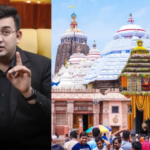VVPAT case: Supreme Court says ‘we can’t control elections, poll body cleared doubts’
NEW DELHI, APR 24 : While hearing petitions seeking the complete verification of votes cast using Electronic Voting Machines (EVM) with Voter Verifiable Paper Audit Trail (VVPAT), the Supreme Court on Wednesday said “we don’t control the elections, the poll body has cleared doubts”.
A two-judge bench of the Supreme Court comprising Justices Sanjiv Khanna and Dipankar Dattahad sought clarification from the Election Commission of India on five queries regarding the functioning of EVMs.
Snakes on a plane: Man flies from Bangkok with 10 anacondas, arrested
“We cannot control the elections, we cannot control the functioning of another constitutional authority,” the court said.
“The ECI has cleared doubts. We cannot change your thought process. We cannot issue a mandamus on the basis of suspicion.”
As the hearing was underway, Justice Khanna said, “We went through the FAQs. We just wanted three-four clarifications. We don’t want to be factually wrong but doubly sure of our findings and hence we thought of seeking clarification.”
A lawyer appearing for one of the petitioners, said that source code of EVMs should also be disclosed for transparency.
To this Justice Khanna replied, “The source code should never be disclosed. If it is disclosed, it will be misused. It should never be disclosed.”
“We just wanted clarifications. One is, is the microcontroller installed in the controlling unit or in the VVPAT? There seems to be indication, we were under the impression that the microcontroller is in the Control Unit. We were told that VVPAT has a flash memory,” he said.
“Second thing we wanted to know is the microcontroller installed. Is it one time programmable? Confirm that. Third, you refer to Symbol Loading Units. How many of them are available? Fourth thing is, it was said the limitation for election petitions is 30 days and hence the data was stored for 45 days. So the period for storage may have to be correspondingly increased?” he asked.
“The other thing is whether the Control Unit is only sealed or the VVPAT is kept separately, that we want some clarification.”
The bench then asked the concerned Election Commission official to be present in the court to reply to the queries.
Presently, VVPAT verification is done only in five randomly selected EVMs in each Assembly segment of a parliamentary constituency.
Earlier this month, the Supreme Court had issued a notice the ECI on a petition seeking the counting of all VVPAT paper slips in elections, instead of verifying only the five randomly selected EVMs.
The petition challenged the Election Commission’s guidelines that mandate that VVPAT verification shall be done sequentially, that is one after the other, thereby causing undue delay.
It contended that if simultaneous verification was done and an additional number of officers were deployed for counting in each Assembly constituency, then complete VVPAT verification could be done in just five to six hours.
On its part, the poll body has asserted that EVMs cannot be tampered with under any circumstances and that the complete counting of the VVPAT slips was not practically feasible.
During a hearing on April 18, the Commission told the Supreme Court that it was pained by what was said about VVPAT slips in EVMs and underlined that it took “painstaking efforts” to prepare for the elections for the past three years.
It also underlined that all EVMs undergo mock drills before being deployed for elections and that candidates are allowed to randomly pick up 5 per cent of the machines.
The ECI said that the process is repeated on the voting day.
-PTI





